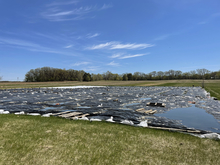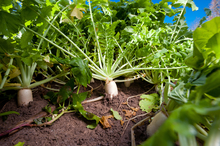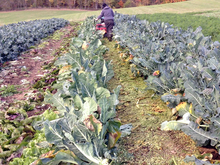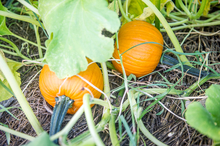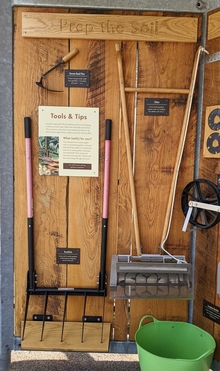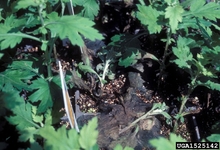Quick facts
- Tillage is harmful to soil in the long term, but it provides short-term benefits that can make growing vegetables easier.
- Alternative strategies can achieve the same benefits as tillage.
- Tillage is traditionally used to create new plots, to loosen and aerate soils, and for weed and disease management.
- Solarization, more targeted tillage tools, and cover crops are a few alternatives to tillage that can help growers achieve these goals.
Reducing tillage provides long-term benefits to soil health. Soils that experience reduced tillage tend to have more stability, resistance to compaction, improved water holding capacity, less erosion, and enhanced biological activity.
For a full discussion of the benefits of reducing tillage, read more about reducing tillage in field crops.
While tillage is harmful in the long term, it provides short-term benefits that can make growing vegetables easier. We'll examine why farmers till their soil and alternative strategies to achieve the same benefits.
Breaking up compact soils
Breaking up compact soils is one of the primary reasons that people till their soil. Tillage can be used to create new plots in areas that were previously under different management strategies (such as turfgrass or pasture), but it is also used annually to help loosen soils before planting.
Tarps
Solarization (applying clear plastic tarps to the landscape) and occultation (applying opaque plastic tarps to the landscape) are simple and effective strategies for killing and breaking down surface vegetation. While these strategies are impractical for large-scale plantings, they can be very useful for opening up new plots for small-scale growers.
- Common materials include silage tarps (typically 50 feet x 100 feet) and billboard tarps (typically 15 feet x 50 feet).
- Depending on existing vegetation and weather conditions, solarization tends to take around 2-3 weeks to kill existing vegetation, and occultation takes about 4-6 weeks.
- Leaving tarps on fields a bit longer can help speed up the decomposition process, leaving a layer of organic matter on the soil surface.
- In very small-scale systems such as home gardens, cardboard boxes can be used.
Additional aeration
Depending on the soil structure of the new planting area, additional aeration may be required to reduce compaction. In an ideal scenario, a grower could wait a year to start growing cash crops in a new field and instead plant cover crops the first year.
For compact soils, a cover crop mix should contain either taproot crops like radish and sugarbeet, or cover crops with very deep root systems like sorghum sudangrass (sometimes called Sudex) for optimal aeration.
Keep in mind that cover crop mixes are not always designed for vegetable growers, and may contain species that will interrupt your crop rotations (such as radish for Brassica growers).
For growers who need to plant crops in a field immediately after clearing vegetation, some degree of tillage may be necessary. Broadforks are excellent tools for aerating soil while minimizing disturbance, but broadforking is hard, physical work and not very practical on a large scale.
Read the following section on managing compaction in established fields for an overview of less intensive tillage implements for larger-scale growers.
Cover crops
One of the most important strategies growers can use to manage compact soils is planting deep-rooted cover crops. For compact soils, a cover crop mix should contain either taproot crops like tillage radish and sugarbeet, or cover crops with very deep root systems like sorghum sudangrass (sometimes called Sudex) for optimal aeration.
Take care to avoid planting cover crops in the same families as your primary vegetable crops to avoid disease and insect pest pressure. For example, planting tillage radish in the fall might be risky if broccoli will be planted in the same field the following year.
More information about cover crop selection for vegetable growers.
Less aggressive tillage implements
For growers who rely on tillage implements that cause a high degree of soil disturbance such as rototillers or moldboard plows, simply phasing out this equipment over time with tools that disturb the soil to a lesser degree can help to reduce compaction. Medium-intensity tillage implements that can help break up compact soil include chisel plows, discs, and vertical tillage.
Read more about various tillage implements.
Keep in mind that while tillage aerates soil in the short term, it breaks up beneficial soil aggregates, and leads to more compaction in the long-term.
While these lower and medium intensity tillage implements are better than traditional tillage tools like the moldboard plow, they can lead to similar problems if used in excess. In some cases, growers find that they need to make multiple passes with these tools to achieve the benefits they need.
Each farm is different, and the success of these less intensive tillage implements will depend on soil type and other management factors.
Permanent beds
Some Minnesota growers, especially growers on heavier soils, have moved to permanent raised bed systems. While many growers who use raised beds re-shape them each year, this process comes with a high degree of soil disturbance, which can lead to compaction in the long-term.
Permanent beds are beneficial for many reasons.
- They allow growers to confine their foot traffic and equipment to the pathways, which reduces compaction in the beds.
- They also allow for more permanent living pathways between beds, and can be less labor intensive for smaller farms with limited access to equipment.
- Pathways are typically covered with mulch, or planted with cover crops.
- The most common cover crop for pathways is white clover; it is often supplemented with a nurse-crop like oats or rye.
Farms vary significantly in how they manage the beds in permanent bed systems. Some use tillage in the beds, others use moderate or reduced tillage practices, and others use no tillage at all in the beds.
Residue and cover crop management
Incorporating residues into the soil is important for a few reasons. Plant residues on the surface can serve as hosts on which insect pests and crop pathogens survive between growing seasons. Decomposing green matter, like crop residues or cover crops, can also compete for nutrients in the soil.
It is ideal to have a majority of the residues broken down at the time of planting. Tillage helps speed up the process by breaking residues into smaller pieces and burying them in the soil where they are more accessible to microbes.
However, tillage also compacts the soil and degrades soil structure over time. There are a few strategies growers can use to manage residues with limited tillage.
Less intensive tillage
Growers using intensive tillage implements such as rototillers and moldboard plows should consider shifting to less intensive implements. Chisel plows and field cultivators are good choices for terminating cover crops because they have both horizontal and vertical action, and they leave limited residue on the surface of the soil.
Some reduced tillage approaches like vertical tillage and coulter carts are less effective because they do not incorporate a horizontal tillage component, and tend to leave at least 50% of the residue on the soil surface. These implements are useful for other purposes such as cutting up residue and creating smooth seedbeds, but will not effectively incorporate cover crop residues.
Another approach that many smaller-scale growers use is to flail mow cover crops and other crop residues, followed by a broadfork to integrate the residue into the soil.
Strip tillage
While strip tillage has gained traction among field crop growers, it is still relatively rare among vegetable farmers. The basic concept of strip tillage is to confine tillage to narrow tilled strips, and leave the area between the strips untilled. The area between strips often contains a cover crop, either living or dead.
Strip tillage allows growers to break up compaction, apply fertilizers, and create a nice, even seedbed in the areas they plan to plant, while reaping the benefits of not tilling between rows such as improved water infiltration, better weed control from cover crops.
Dr. Ajay Nair’s lab at Iowa State University has spent many years examining strip tillage options for vegetable growers.
Match tillage to existing residue levels
The amount of residue on the soil surface at the end of the year or at the time of termination will depend on a variety of factors including crop and cover crop species, planting date, and weather.
The tools you use to manage cover crops or other crop residues may vary from year to year depending on the amount of residue present. While using less intensive tillage implements is preferable, growers may end up needing to till multiple times if the tillage implements chosen do not sufficiently break down and bury the residues.
When residue is limited (following a winter-killed cover crop that has had time to break down), using a less aggressive tillage implement would be appropriate.
In higher residue situations, a more aggressive tillage implement or multiple passes may be necessary for preparing seed beds.
Cover crops and reduced tillage are both important for soil health, but often cover crops require tillage for termination. The following methods can help to reduce the need for tillage when terminating cover crops.
Using winter-killed cover crops
Sticking to winter-killed cover crops can reduce or even eliminate the need for tillage to incorporate the cover crop residue. Fall planted cover crops like oats, field peas, or radish, and warmer season cover crops planted in late summer will naturally die from cold temperatures over the winter. Usually these cover crops are fairly well broken down by the time spring planting comes along.
Mowing
Mowing cover crops can be an effective way to terminate cover crops if done in a timely manner. For growers who do not use herbicides, mowing tends to be most effective when the cover crop reaches the flowering stage. Mowing before this point may result in re-growth.
Find crop specific termination instructions.
Mowing can also help speed up the breakdown process, which is especially important for cover crops planted in the spring or summer that will be followed with a fall vegetable crop.
Flail mowers in particular chop residue into very small pieces, and can help to disperse residue evenly across the soil surface.
Flail mowers are not suitable in all cases; for example, when spring rye is terminated with a flail mower it can form a thick mat on the soil surface, so a sickle bar mower is a better choice. However, in most cases, flail mowers are appropriate and can speed up the breakdown process.
Tarps
More and more researchers are looking into the use of tarps (solarization and occultation) to speed up the breakdown process of cover crops and assist in termination.
Mowing is sometimes insufficient to terminate a cover crop. However, tarps applied to the field after mowing can help to ensure that a cover crop does not re-grow.
Trials from Wisconsin on diversified vegetable farms showed that plastic tarps successfully terminated a rye and vetch cover crop within 21 days. They trialed three types of plastic: 5ml white/black plastic, 6ml white/black plastic, and black landscape fabric. All three were successful.
Research studies do not consistently show that tarps actually speed up the decomposition of cover crops residues; in some studies residues break down more quickly, but in others tarps have no effect.
In a 2018 study, black plastic tarps applied to fields after terminating a rye and vetch cover crop by roller crimping increased the yields of the next crop (transplanted cabbage), and helped to more quickly break down cover crop residues. The authors hypothesized that this was due to accelerated biological activity with more consistent temperature and moisture conditions under tarps compared to open fields. Especially during dry conditions, watering a field prior to installing a tarp can help improve the efficacy.
Another study found that tarps increased nitrate concentrations in the soil. Nitrates leach readily from soil, and by physically blocking rainfall, tarps retain more nitrates in the soil profile. Reduced nitrate leaching is beneficial for both the growth of the next crop and for the environment.
Tarps tend to also increase the temperature of the soil, which promotes microbial activity, which in turn may increase the rate of nitrification in the soil. Generally clear tarps produce the hottest environment, followed by black plastic tarps. Conditions under each type of tarp are hotter than bare soil.
Planting into residues
Growers who wish to reduce tillage can plant directly into cover crop residues. Large-seeded crops like pumpkins can be planted directly into the residues, and smaller seeded crops can be transplanted. The most common example of this system involves terminating a winter rye cover crop at the time of anthesis (flower formation) with a mower and sometimes herbicides.
Pumpkins are then planted directly into the residues, which serve as a mulch and help to reduce weed pressure. The mulch keeps the pumpkins clean and can reduce cleaning costs, especially for growers who sell to wholesale markets that demand very clean pumpkins. The mulch also acts as a barrier between plants and the soil, which can help to limit soil borne disease pressure.
Keep in mind that straw mulch tends to keep the soil slightly cooler than bare ground in the summer (but slightly warmer in the winter), and so this method may be less suitable to heat-loving crops. In very wet years, this system can result in excess moisture. It is most commonly used in sandy soils that drain quickly.
For a discussion about no-till pumpkins planted into a rolled cover crop, listen to the Vegetable Beet podcast, Pumpkin Planting for Halloween Markets episode, starting at 26:00.
Herbicides
Herbicides can also be used to terminate cover crops. Herbicides are most effective when crops are young and actively growing, during warm, dry conditions.
Refer to the Midwest Vegetable Production Guide for up-to-date herbicide recommendations for vegetable crops.
Livestock
Some vegetable farmers are beginning to use livestock to graze cover crops in the fall. Keep in mind that for food safety reasons, growers should only bring livestock into vegetable fields that will not receive another crop for that season.
Typically livestock do not fully terminate cover crops, but rather they essentially “mow” the cover crops down until they are winter killed. They also help to reduce the amount of residue left in the field in the fall while still providing valuable organic matter in the form of manure, so that when the cover crop dies over the winter, less breakdown needs to occur in the spring.
Preparing fields for planting
Conventional wisdom regarding seedbeds, especially for small-seeded crops like carrots and beets, is that a perfectly smooth seedbed is necessary for good germination. Clods on the surface can smother small seedlings, and an uneven soil surface can result in variable seeding depths and access to moisture.
In recent years, growers using no-till and reduced till methods have adopted two main strategies to avoid the need for perfect seedbeds:
- Using a row cover right around the time that you expect seedlings to germinate and leaving it on for a week or two helps to hold moisture near the soil. While this doesn’t solve the issue of clods, it does significantly help maintain moisture in the top couple inches of soil. Growers seem to have good success germinating small-seeded crops like beets and carrots this way in reduced tillage systems.
- Transplanting instead: Transplanted vegetables do not require the same smooth seed bed that direct seeded crops need. More and more growers are using PaperPot transplanters for small-seeded crops like beets (though this is an uncommon practice for carrots and mesclun). This technology has made transplanting more affordable and less labor intensive.
Regardless of the smoothness of the seedbed, small-seeded crops are finicky and require constant moisture. Invest in irrigation for the first couple of weeks after planting. This is especially important in soils that are prone to crusting; keeping the soil moist helps to promote seedling emergence by preventing crusting on the surface.
Finally, tools like tilthers can break up clods on the surface to create an even seedbed surface without disturbing the soil below. These shallow tillage implements tend to till the soil down to about 2 inches, and so the integrity of the soil structure below is preserved. If the soil is very compact, using a broadfork can help to aerate the soil right before tilthing and planting.
One of the primary reasons that people till their soil in the spring is to warm and dry the soil for planting.
The actual dynamics of soil warming and tillage are complex; residues on the soil surface can hold in heat, but they can also reflect light rather than absorbing it. Soils with light-colored crop residues tend to be slightly cooler than bare soil around the time of planting.
Strategies for warming the soil and drying it out in the spring
Raised beds
- Raised beds should ideally be created in the fall to achieve optimal soil warming and drying in the spring, and to avoid compaction caused by working in wet soil conditions.
- Raised beds allow the planting area to dry faster by diverting water into the walkways between beds.
Tarping and plastic
Using plastic is another strategy for warming and drying fields.
- One method is to simply place tarps on the soil surface starting a month or two before planting. This practice keeps water out of fields and helps to warm the soil. It has the added benefit of killing the first flush of weeds and retaining nitrogen in the soil (read the section on using tarps to terminate cover crops for more details).
- Another option is to use plastic mulch over raised beds, which can be applied to raised beds as soon as growers can enter their fields. Plastic mulch warms the soil and regulates moisture.
- Dibble tools can be used at the time of planting to make holes in the plastic mulch for transplanting.
- For sturdier plastic mulches like landscape fabric, burning tends to result in more durable holes that are less prone to tearing than those that are cut or punctured.
Transplanting
With increasingly unpredictable and wet spring weather, more and more growers are moving away from direct seeding. By sticking to transplanted crops, growers have a bit more flexibility around the time of planting. In the case of exceedingly wet spring weather, transplants can allow farmers to wait to plant without significantly delaying crop growth and development.
Strip tillage
Strip-tilled fields tend to warm up more quickly than no-till fields. Read more about strip tillage above.
Fertilizer incorporation
Ideally, fertilizer should be incorporated into the soil for maximum plant uptake and minimum losses to the environment. Applying nitrogen on top of the soil can lead to denitrification, and applying phosphorus on top of the soil can lead to runoff. So how can we incorporate nutrients into the soil while still minimizing soil disturbance?
- Banded applications: Apply fertilizer in furrows at a depth of 4-6 inches using a coulter, or in small-scale systems a Dutch or Warren hoe. There is still some degree of disturbance with this approach, but it is far more targeted than tillage. Do not apply directly into furrows where you are seeding to avoid burning plants; make your furrows for fertilizing a few inches away from your crops.
- Injecting fertilizer into the soil: This is a common approach among field crop growers, who directly inject anhydrous ammonia and ammonium nitrate in field crops. These types of fertilizers are not as common in vegetables.
- Strip tillage: Strip tillage and permanent bed systems allow for more traditional incorporation of fertilizers while still maintaining beneficial residue levels across the field.
Fertigation: Fertigation refers to the application of fertilizers through irrigation water. Many vegetable farmers already use fertigation in high tunnels. This is an effective way to inject fertilizer directly near the root system and the water helps to pull nutrients deeper into the soil profile.
Disease, insect, and weed management
Tillage may have less of an impact on insects and pathogens than is commonly thought, but it does have a significant impact on the dynamics of your weed seedbank and timing of emergence of weed seedlings.
There is a basic assumption that burying plant debris and removing residues helps to reduce disease incidence because residues break down faster when they are chopped and incorporated, or heated in a compost pile. While this is true for many diseases, it does not necessarily mean that growers using reduced tillage will face substantially more disease pressure, especially if they are also using disease management best practices such as crop rotation and resistant varieties.
The pathogens most impacted by reduced tillage are those that are soil-borne and impact a wide variety of crop families. Most notably, Rhizoctonia solani, a pathogen involved in damping off as well as various root and stem rots, is consistently cited as more problematic in reduced tillage systems. This pathogen has a wide host range and survives in colonized plant debris in the soil. Vegetable growers may choose to start seedlings indoors and transplant rather than direct seed if damping off is a problem on their farms, thus helping to reduce both disease incidence and impact.
No-till systems, especially organic no-till systems, are sometimes weedier than conventional fields. As such, weed pressure may contribute to increased disease incidence due to the presence of alternative hosts for pathogens, which create a “bridge” for the pathogen to survive in a field between rotations of susceptible crops. High weed pressure may also impact the microclimate around your crops, creating a more dense and humid canopy. These conditions may be favorable for disease.
However, some diseases are actually reduced in no-till systems. Because these systems have higher microbial abundance and diversity, there can be more competition between microbial communities in the soil. For pathogens that are specific to crop families, sufficient rotation is more important than your tillage practice. Where genetically resistant or tolerant varieties are available, using them may also have a more significant effect on disease pressure than your tillage practice.
In a 2020 paper summarizing 29 studies about insect pests and 30 studies about predator insects in different tillage systems, the authors found that, while results may vary in individual studies, overall there does not seem to be a difference in the abundance of insect pests between reduced-till and conventional-till systems.
Studies about predator insects were quite variable, but in general, the number of predators collected from plant leaves was similar between no-till and high-disturbance treatments. Soil-collected predators were more abundant in no-till compared to high-disturbance treatments.
The final reason that growers may wish to till their soil is for weed management. Tillage helps to bury weeds and is an important weed management strategy for organic growers. In general, a shift to reduced tillage tends to favor perennial weeds. Tillage agitates the soil and can disrupt the root systems of perennials, and in the absence of tillage, these plants tend to become more prominent. Read more about weed seedbank dynamics under various tillage systems here.
Reduced and no-till growers have a few strategies for managing weeds:
- Shallow cultivation: While cultivation is a form of tillage, shallow cultivation disturbs only the top inch of soil. Shallow cultivation essentially uproots recently germinated weeds, and is most effective when weeds are in the “white thread” stage, only a quarter of an inch tall, and so growers who rely on mechanical cultivation should cultivate early and often until the crop canopy fills in. It is worth noting that mechanical cultivation is most effective on annual broadleaf weeds, and is likely not a sufficient strategy for farmers with a lot of grasses or perennial weeds in their fields. More about shallow cultivation.
- Stale seedbed: Stale seedbeds are a simple but important management strategy for all growers. The basic concept of a stale seedbed is that prior to planting a crop, a grower prepares the field, and then allows it to rest for anywhere from 1-3 weeks. In that time, the first flush of weeds will emerge, giving the grower an opportunity to pass through the field using shallow cultivation, flaming, or herbicides. Following that pass, the main crop is planted. If it has a long germination window, growers often do another shallow cultivation or flaming pass immediately prior to germination.
- Herbicides: While most Minnesota specialty crop growers are organic or use organic practices, herbicides are an effective option for growers who choose to use them. Growers should consult the Midwest Vegetable Production Guide for Commercial Growers for up-to-date herbicide recommendations.
- Solarization and occultation: Using tarps to kill weeds is a common strategy among no-till growers. It is an especially common practice for growers who have tricky patches of perennial weeds like thistle. Keep in mind that while tarping a field at the beginning of the season can prevent perennial weeds from emerging during the remainder of the season, they are unlikely to die after only one season of solarization.
Additional resources
In 2020 University of Minnesota Extension and Land Stewardship hosted four virtual field days at vegetable farms, highlighting reduced tillage and other soil health practices. You can view the videos from each field day.
Klodd, Annie; Hoidal, Natalie. (2019). Needs Assessment of Minnesota Fruit and Vegetable Producers. Retrieved from the University of Minnesota Digital Conservancy.
Lounsbury, N., Warren, N., Wolfe, S., & Smith, R. (2020). Investigating tarps to facilitate organic no-till cabbage production with high-residue cover crops. Renewable Agriculture and Food Systems, 35(3), 227-233. doi:10.1017/S1742170518000509
Rowen, E., K. Regan, M. Barbercheck, J. Tooker. (2020). Is tillage beneficial or detrimental for insect and slug management? A meta analysis. Agriculture, Ecosystems & Environment, 294(1)
Rylander, H., Rangarajan, A., Maher, R. M., Hutton, M. G., Rowley, N. W., McGrath, M. T., & Sexton, Z. F. (2020). Black Plastic Tarps Advance Organic Reduced Tillage I: Impact on Soils, Weed Seed Survival, and Crop Residue, HortScience, 55(6), 819-825.
Smith, G., Birthisel, S., Gallandt, E. (2017). Comparing solarization & occultation. University of Maine Weed Ecology and Management.
Strader, C. 2018. Use of Tarps to Terminate High-Residue Winter-Hardy Cover Crops Before No-Till Organic Vegetables. SARE Partnership Grant ONC17-033.
Sumner, D., B. Doupnik, M.G. Boosalis. (1981). Effects of reduced tillage and multiple cropping on plant diseases. Annual Review of Phytopathology, 19: 167-187.
Turner M.K. (2020) Challenges and Opportunities in Managing Diseases in No-Till Farming Systems. In: Dang Y., Dalal R., Menzies N. (eds) No-till Farming Systems for Sustainable Agriculture. Springer, Cham. https://doi.org/10.1007/978-3-030-46409-7_9
Reviewed in 2021


